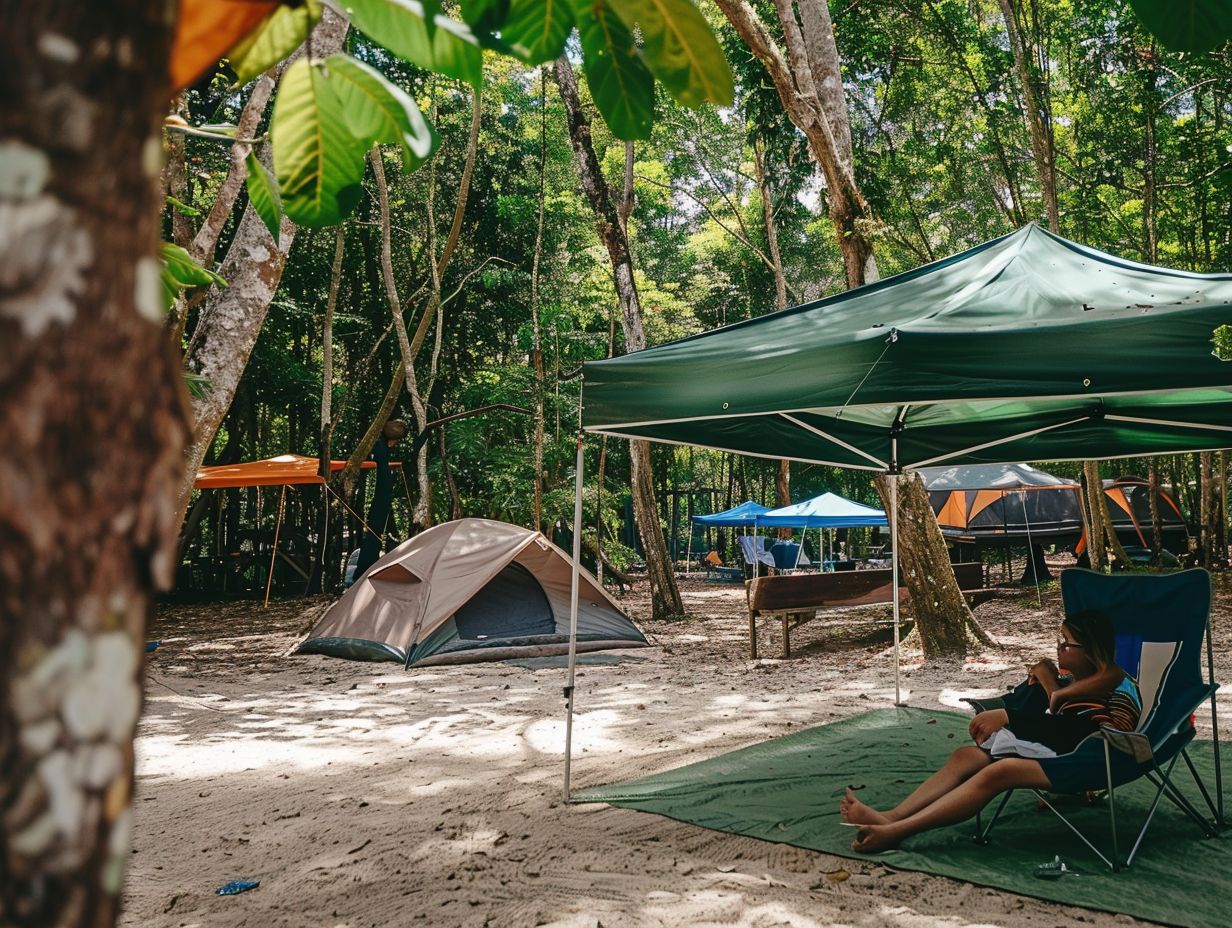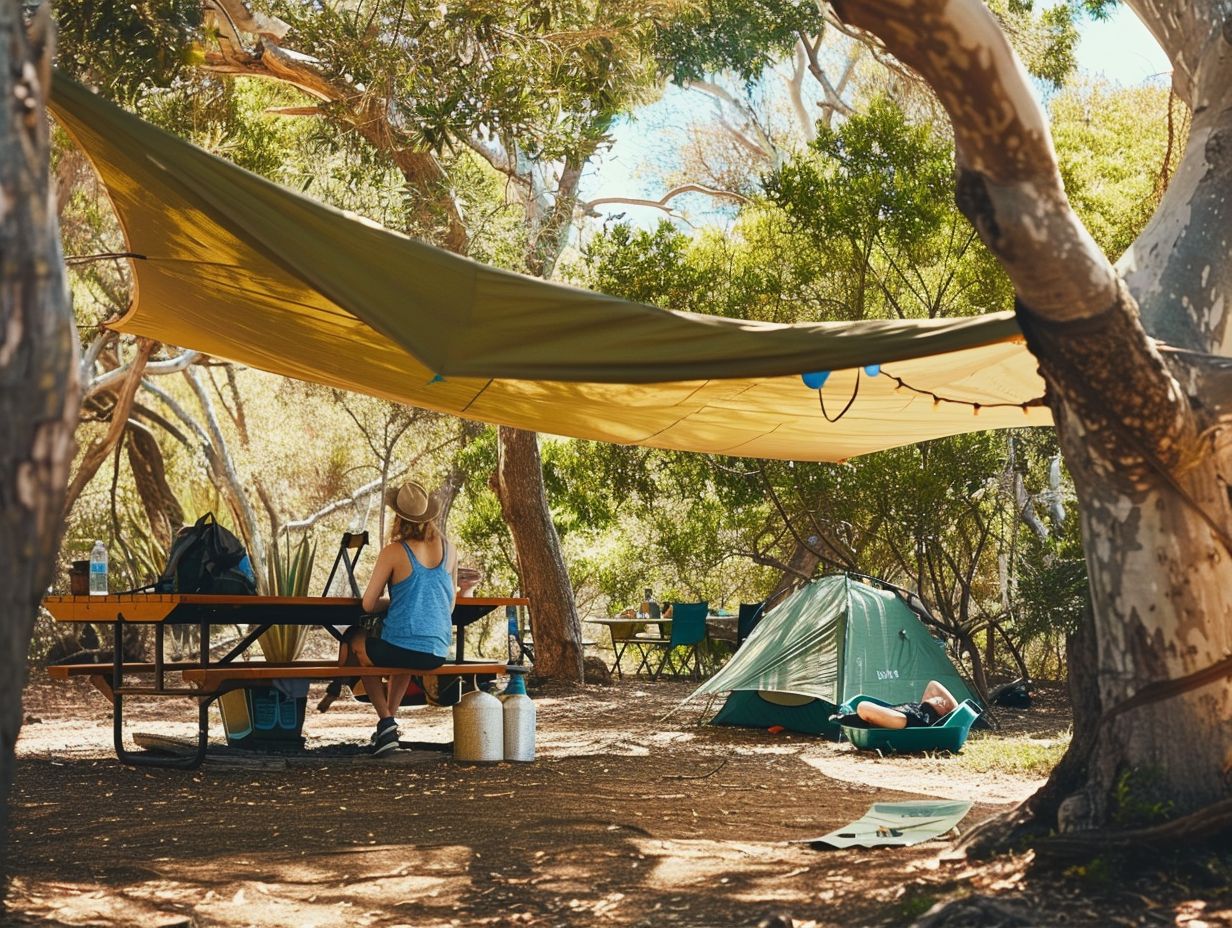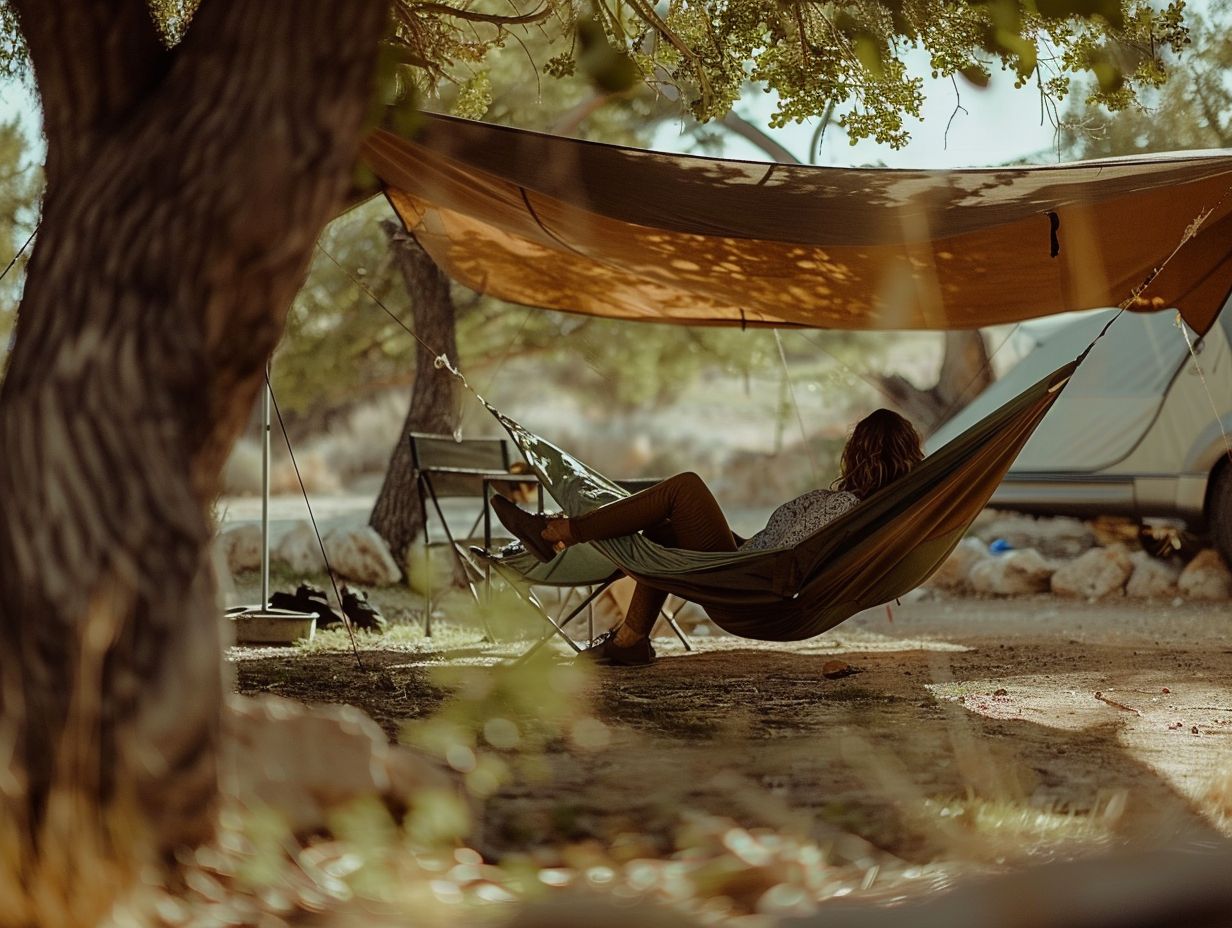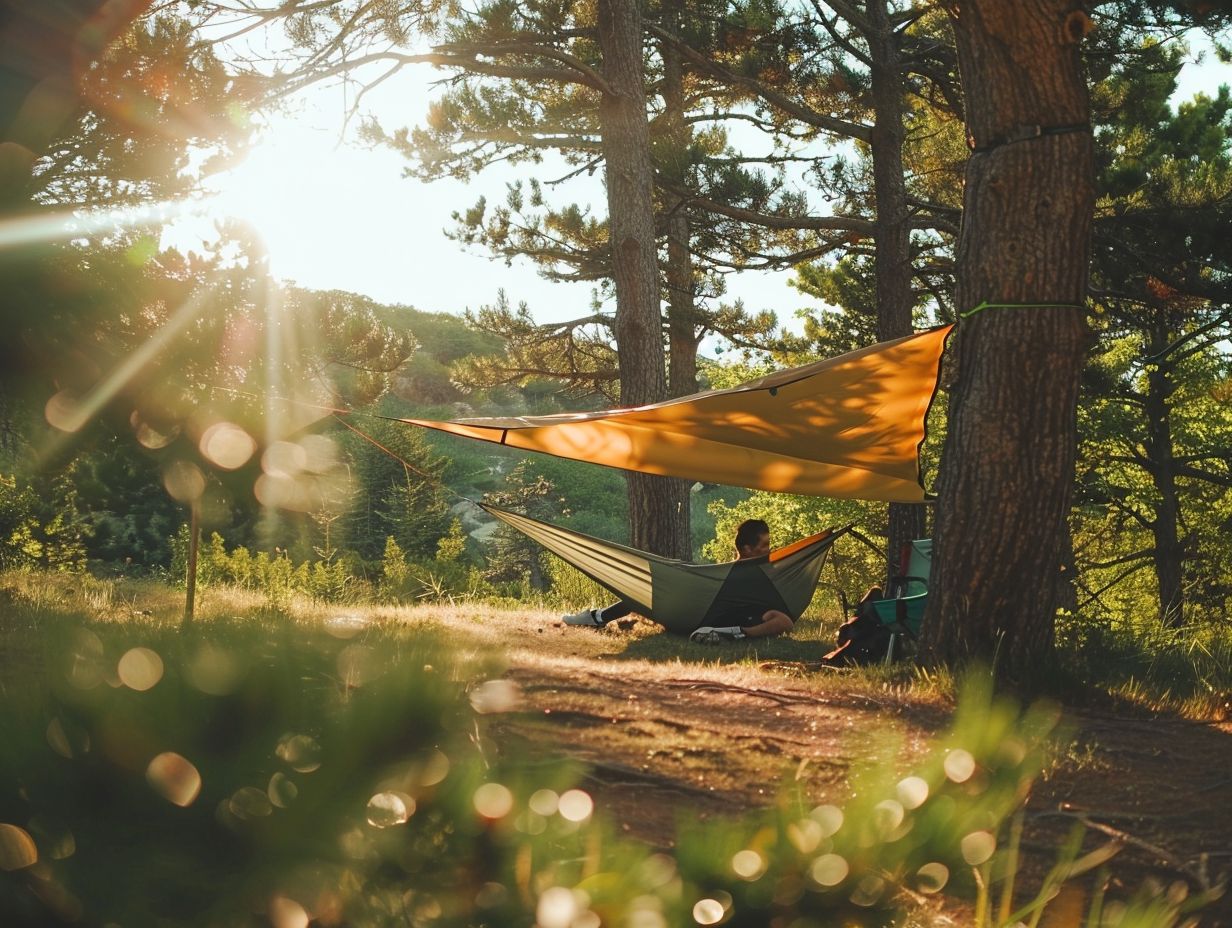During your summer camping adventures, staying cool is essential, especially when the heat is on. In this article, 15 practical tips will be shared to help you beat the heat and fully enjoy your camping trip. These tips range from selecting a shaded campsite to using cooling products and recognising the symptoms of heat exhaustion.
Rest assured that we have everything you need to know to ensure a comfortable camping experience in the summer heat. So grab a refreshing drink and continue reading to learn how to keep cool during your outdoor adventures.
Key Takeaways:

- Choose a campsite with natural shade to stay cool and avoid direct sunlight.
- Bring a portable fan to keep air circulating and create a cooling breeze.
- Stay hydrated by drinking plenty of water and avoiding sugary drinks or alcohol.
1. Choose a Campsite with Shade
When planning for a camping trip in the summer heat, you should prioritise selecting a campsite with ample shade to ensure a more comfortable and cooler experience.
Shade not only provides relief from the scorching sun but also helps in lowering the overall temperature within the camping area. Natural shades such as under the canopy of large trees or beside rock formations offer excellent protection from direct sunlight.
It is advisable to look for spots where shadows are consistently cast throughout the day, especially during peak heat hours.
Setting up tents under these shaded areas can significantly reduce the need for constant cooling measures like fans or air conditioning, thereby enhancing your camping experience by making it more pleasant and enjoyable.
2. Bring a Portable Fan
When trying to keep cool in your tent during hot summer nights, you should consider bringing a portable fan to enhance airflow and generate a refreshing breeze for improved sleep quality. A portable fan not only boosts airflow but also assists in decreasing humidity levels within the tent, helping to alleviate that stifling sensation.
When choosing a portable fan for camping, it is recommended to select one that is compact, lightweight, and powered by batteries for added convenience.
To position the fan effectively, place it at one end of the tent, directed towards the entrance to draw in fresh air. If feasible, raise the fan slightly to enhance air circulation throughout the entire tent space, ensuring a comfortable and restful night’s sleep.
3. Use a Reflective Sun Shelter
Protect yourself from the intense summer sun by using a reflective sun shelter that can deflect heat and UV rays, creating a cooler outdoor haven at your campsite.
These innovative sun shelters are crafted to establish a comfortable shaded space that not only safeguards you from harmful UV rays but also reflects heat, enhancing your outdoor experience.
Brands such as Therm-a-Rest and Outdoor Research are well-known for their high-quality sun shelters that are lightweight, easy to assemble, and long-lasting.
Featuring adjustable poles, reflective fabrics, and UV protection coatings, these shelters offer a blend of practicality and elegance. Whether you are camping, having a picnic, or enjoying the beach, acquiring a reflective sun shelter from a reputable brand can elevate your outdoor escapades.
4. Stay Hydrated
In the scorching summer heat, staying hydrated is essential for keeping cool and maintaining your energy levels while camping.
Carrying a reusable water bottle such as L.L.Bean provides a convenient way to ensure that you have access to water throughout the day. This simple habit of regularly drinking water not only prevents dehydration but also helps in regulating body temperature and preventing overheating, especially in outdoor settings.
Adequate hydration is crucial for overall well-being, as it supports various bodily functions and helps in flushing out toxins. By making a conscious effort to drink water consistently, you can enjoy your camping trip to the fullest without succumbing to the risks of dehydration and heat exhaustion.
5. Take Advantage of Natural Bodies of Water

If you have the opportunity, consider utilising natural bodies of water such as rivers, lakes, or streams in proximity to your campsite for activities like cooling off, swimming, or unwinding in the rejuvenating waters during the summer’s intense heat. These natural water sources not only offer a respite from the rising temperatures but also serve as a picturesque backdrop for your camping expedition.
When engaging in swimming or other water-related activities, prioritising safety is paramount. It is essential to be cautious of the water conditions, currents, and depth before entering.
Implementing a buddy system and closely supervising children near the water are crucial safety measures. Ensure that you have necessary safety equipment like life jackets and first aid kits on hand. Refrain from swimming solo or under the influence of alcohol.
Adhering to these safety guidelines will allow you to fully enjoy the serenity and relaxation that natural water sources contribute to your camping experiences.
6. Dress Appropriately
Select lightweight and breathable clothing suitable for summer camping to assist in regulating your body temperature and ensuring comfort in the heat. Brands such as Trew or Voormi are recognised for their summer-appropriate fabrics that are lightweight and possess moisture-wicking properties, helping to keep you dry and cool during your outdoor pursuits.
Complement these garments with a broad-brimmed hat to shield your face from the sun, polarised sunglasses for eye protection, and a high SPF sunscreen for added defence against harmful UV rays. By making informed choices regarding your attire and accessories, you can guarantee a secure and pleasant camping experience in the summer sun.
7. Use Cooling Products
Enhance your camping experience in hot weather by utilising cooling products such as cooling neck wraps, thermal blankets, or even swamp coolers to effectively combat the summer heat.
To further elevate your camping comfort, consider investing in innovative cooling solutions like portable misting fans from reputable brands such as Jet Stream. These fans provide a refreshing breeze on-the-go, ensuring you stay comfortable in the heat.
Additionally, to ward off pesky mosquitoes, a Thermacell mosquito repellent device can create a protective barrier, allowing you to enjoy the outdoors without the nuisance of bites.
With a wide range of cooling products available, campers can customise their gear to stay cool and comfortable during their outdoor adventures.
8. Plan Activities for Cooler Times of the Day
To avoid the peak heat of summer days, plan your camping activities for cooler times like early mornings or evenings when temperatures are more bearable and conducive to outdoor fun.
Early mornings are perfect for a peaceful hike, immersing yourself in the beauty of nature as the sun rises. The crisp air and gentle sunlight create an ideal setting for birdwatching or simply enjoying the quiet serenity of the outdoors.
As night falls, stargazing can be a magical experience, away from the hustle and bustle of the day. Remember to pack layers to stay warm as temperatures drop and to hydrate adequately during these cooler periods to avoid heat exhaustion.
9. Avoid Cooking During the Hottest Hours
Reduce your risk of heat exposure while camping in the summer by avoiding cooking during the peak hot hours of the day.
Instead, choose cooler times or opt for no-cook meal options. Prepared meals can be a valuable asset in these circumstances, providing you with a tasty meal without subjecting yourself to prolonged heat exposure.
Brands like MSR and GSI Outdoors offer lightweight and durable cookware suitable for quick recipes that involve minimal cooking, such as putting together sandwiches or salads. Additionally, snacks like trail mix, energy bars, or fruits are convenient and refreshing choices for hot weather camping excursions.
10. Use a Wet Towel or Bandana

Combat the summer heat during your camping trips by applying a wet towel or bandana to your neck, forehead, or pulse points. This simple yet effective method provides immediate cooling relief, thanks to the principle of evaporative cooling.
When water evaporates, it absorbs heat from its surroundings, including your skin, creating a refreshing sensation. By placing a damp towel on your body, the gradual evaporation of water helps draw away heat energy, much like how sweating aids in regulating body temperature.
To maximise the effectiveness of this technique, consider investing in lightweight, quick-drying towels designed specifically for this purpose. These towels offer easy portability and can be used repeatedly during your outdoor excursions, ensuring you stay cool and comfortable in hot weather.
11. Set Up a Hammock
Enhance your camping experience by creating a peaceful and more comfortable lounging area at your campsite with a hammock placed under the shade. This will provide you with a relaxing and breezy retreat during your summer camping adventures.
Hammocks offer various benefits for camping enthusiasts. Their design promotes better airflow, helping to keep you cool during warm days and nights. Plus the exceptional comfort they provide for lounging or sleeping, hammocks offer a unique way to relax in nature, enhancing your overall camping experience.
When you set up your hammock, it is important to ensure that it is securely fastened using a reliable suspension system to ensure safety and stability. Choose locations with robust and appropriately spaced trees to support your hammock setup, allowing you to enjoy a peaceful and revitalising rest surrounded by the beauty of the outdoors.
12. Take Breaks in the Shade
Prioritise your well-being by taking regular breaks in shaded areas during camping to rest, cool down, and avoid prolonged exposure to the scorching summer heat. Shade breaks not only provide relief from the intense sun but are crucial for rehydration, relaxation, and preventing heat-related illnesses.
Setting up comfortable camping chairs or mats in shaded rest areas creates a welcoming oasis where you can unwind, enjoy a cool drink, and revitalise your body. These breaks offer a chance to replenish your energy, lower your body temperature, and reduce the risk of heat exhaustion.
By incorporating regular shaded breaks into your camping routine, you can fully embrace the outdoor experience while safeguarding your health.
13. Use a Cooling Neck Wrap
Ensure your comfort during camping adventures by utilising a cooling neck wrap that delivers a refreshing and calming sensation, effectively countering the impact of heat during your outdoor pursuits.
- Gel-infused cooling neck wraps stand out as a favoured option among campers, offering enduring cooling benefits through gel beads that retain low temperatures.
- In contrast, evaporative cooling wraps function by harnessing the natural process of evaporation to keep you cool in warm settings. These wraps are lightweight and user-friendly, serving as a convenient accessory for hiking or leisure time at the campsite.
By making the choice to acquire a cooling neck wrap, you not only enhance your comfort but also mitigate the risk of heat-related challenges, enabling you to fully relish your outdoor escapades.
14. Bring a Portable Misting System
Beat the heat at your campsite by bringing along a portable misting system that sprays fine water droplets to create a cooling mist, providing relief from the summer temperatures.
Portable misting systems like this are essential for outdoor enthusiasts like you, as they can significantly reduce the ambient temperature, enhancing your camping experience on hot days.
These systems not only offer a refreshing mist that helps cool down the surrounding area but are also compact and easy to transport.
If you are in search of a reliable option, consider compact misting systems such as Ruffwear’s Jet Stream, specifically designed for outdoor use. With its convenient size and effective cooling capabilities, it serves as a vital accessory for any camping excursion.
15. Know the Signs of Heat Exhaustion and Heatstroke

To safeguard your health and well-being during camping in the summer, it’s important to familiarise yourself with the symptoms of heat exhaustion and heatstroke. Recognising early warning signs can help you take prompt action to prevent serious consequences.
Both heat exhaustion and heatstroke are heat-related conditions, but they differ in severity. Heat exhaustion typically presents with symptoms such as excessive sweating, weakness, nausea, and muscle cramps, while heatstroke is a more severe condition characterised by high body temperature, confusion, and potential loss of consciousness.
If you or someone in your vicinity displays signs of heat exhaustion, it’s crucial to move to a cooler area, drink water, and apply cool compresses. In the case of heatstroke, immediate medical attention should be sought, and efforts to lower the individual’s body temperature should be made, such as applying ice packs and using fans.
Preventive measures play a key role in mitigating the risk of heat-related illnesses. Staying hydrated, wearing lightweight clothing, and avoiding strenuous activities during the peak heat hours are all strategies that can help in preventing heat exhaustion and heatstroke.
Frequently Asked Questions
What are some essential tips for staying cool while camping in summer?
Some essential tips for staying cool while camping in summer include staying hydrated, choosing a shaded campsite, and wearing lightweight, breathable clothing.
How important is staying hydrated while camping in summer?
Staying hydrated is extremely important while camping in summer. In the heat, our bodies lose water quickly through sweat, and it’s essential to replenish that water to avoid dehydration and heat exhaustion.
What are some ways to stay hydrated while camping in summer?
Some ways to stay hydrated while camping in summer include drinking plenty of water throughout the day, bringing electrolyte drinks or powders, and eating foods with high water content, such as fruits and vegetables.
Is it necessary to stay in the shade while camping in summer?
Yes, staying in the shade is crucial for staying cool while camping in summer. Direct sunlight can raise your body temperature and increase the risk of heat-related illnesses. Try to find a campsite with natural shade or bring a canopy or tarp to create your own shade.
What type of clothing should I wear while camping in summer?
When camping in summer, it’s best to wear lightweight, loose-fitting, and breathable clothing. Avoid dark colors and opt for light-colored clothing to reflect the sun’s rays. Also, remember to wear a hat to protect your head and face from the sun.
How can I cool down in extreme heat while camping in summer?
If the heat becomes too intense, there are a few things you can do to cool down while camping. Take a dip in a nearby lake or river, use a misting fan or cooling towel, or find a shaded area to rest. You can also soak a bandana or cloth in cool water and place it on your neck or head to help lower your body temperature.



